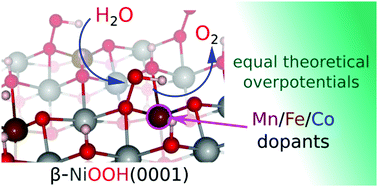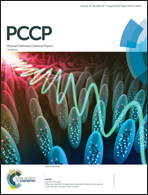Effect of transition-metal-ion dopants on the oxygen evolution reaction on NiOOH(0001)†
Abstract
Iron-doped nickel oxyhydroxide has been identified as one of the most active alkaline oxygen evolution reaction (OER) catalysts, exhibiting an overpotential lower than values observed for state-of-the-art precious metal catalysts. Several computational investigations have found widely varying effects of doping on the theoretical overpotential of the OER on NiOx. Comparisons of these results are made difficult by the numerous differences in the structural and computational parameters used in these studies. In this work, within a consistent framework, we calculate the theoretical overpotentials for reactions occurring on the most stable, basal plane of undoped and doped β-NiOOH. We compare the activities of Fe(III), Co(III), and Mn(III) doping using density functional theory with Hubbard-like U corrections on the transition-metal d orbitals. We compare the effect of surface and subsurface doping in order to establish whether the dopants act as new active sites for the reaction or whether they induce more widespread changes in the material. The results of our study find only a small reduction in the overpotential (∼0.1 and ≤0.05 V when doped in the surface and subsurface layers, respectively) for the three dopants, if doped in the dominant basal plane. This is much less than the reductions of 0.3 V experimentally observed for the most active Fe-doped systems. Furthermore, the magnitudes of reductions in overpotentials for the three dopants are similar. This work therefore disqualifies the possibility of enhancing the activity of the dominant exposed basal plane of β-NiOOH through substitutional doping.



 Please wait while we load your content...
Please wait while we load your content...
